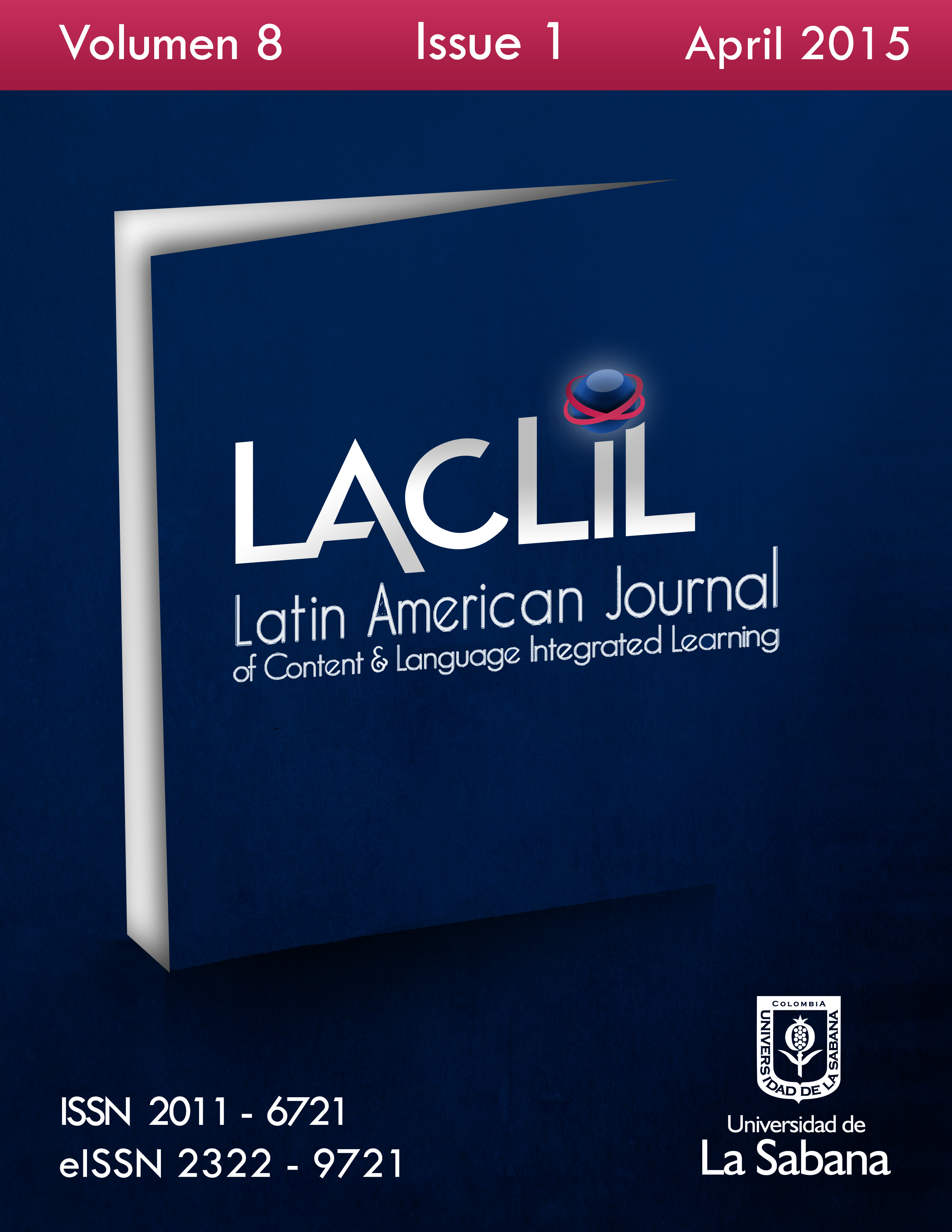Content and language symbiosis in a maieutic, translanguaging pattern: An exploratory practice in Italy
DOI:
https://doi.org/10.5294/4730Palabras clave:
modelo CLSL, translingüismo, intermediación lingüística, marco de aprendizaje, inter-aprendizaje, alerta pedagógica.Resumen
Este artículo tiene como objetivo introducir pre-AICLE a través del modelo CLSL (contenido y lenguas [L1/L2] aprendizaje compartido), que funciona como un puente para una inmersión AICLE completa. Se analizan las características de este nuevo modelo de aprendizaje que surge de las necesidades inmanentes de la realidad educativa italiana informando sobre los resultados en cuanto a la forma en que el contenido y el lenguaje se desarrollan en un patrón de translingüismo. Discute a mayor profundidad el impacto que pueda tener en el ámbito nacional e internacional mediante la observación en la que los matices graduales del preAICLE tienden a calmar y vivificar la experiencia de aprendizaje. Al mismo tiempo, las voces de los actores amplían el papel del modelo CLSL dando vida a un aprendizaje democrático y diversificado que puede percibir la práctica alternativa de AICLE en un modo tripartito. CLSL surge como una fase dinámica que mejora intercontenido y competencias lingüísticas a través de la interpretación de aprendizaje de lenguaje y contenido a través de código de conmutación dialógica y participativa originando una nueva experiencia de inter-aprendizaje..Descargas
Citas
REFERENCES
Agolli, R (2013). A penetrating CLIL praxis in Italian mainstream education: Stemming novelties and visions. Research Papers in Language Teaching and Learning, 4, 138-157. Available from: http://rpltl.eap.gr/current-issue/table-of-contents/16-renata-agolli
Agolli, R (2014). Perceiving CLIL nuances. Iatefl Voices, 237, 12.
Byram, M., Feng, A. (2004). Culture and language learning: teaching, research and scholarship. Language teaching 37(3), 149-168. Retrieved from: http://dro.dur.ac.uk
Clegg, J. (2007). “CLIL in European schools and its relations with minority and mainstream education: Clil e formazione degli insegnanti (Il progetto europeo LICI): Atti del convegno: Torino, Italia.
Council of Europe (2001). Common European Framework of references of languages: learning, teaching, assessment. Cambridge: Cambridge University Press.
Coyle, D., Hood, P., Marsh, D. (2010). CLIL Content and Language Integrated Learning, Cambridge: Cambridge University Press.
Di Martino, E., Di Sabato, B. (2012) CLIL implementation in Italian schools: Can long-service teachers be retrained effectively? The Italian protagonists’ voice. Latin American Journal of Content and Language Integrated Learning, 1(2), 73-105.
Eurydice (2006). “CLIL at School in Europe”. Retrieved [11.01.2014] from: http://www.eurydice.org/portal/page/portal/Eurydice/showPresentation?pubid
Fullan, M. (2001). Leading in a culture of change. San Francisco: Jossey- Bass.
Gibson, M (2012, February, 24). Integrating critical thinking skills in L2 content based learning: decision making optimization based on conflict resolution. Conference Paper: 24th February, University of Navarra, Spain.
Giroux, A. H. (2010). Dumbing down teachers: Rethinking the crisis of public education and the demise of the social state. Review of Education, Pedagogy, Cultural studies, 32 (45), 339-381. Routledge: Taylor & Francis Group.
Hall, N., Sham, S (2007). Language brokering as young people’s work: evidence from Chinese adolescents in England. Language and Education, 21 (1), 16-30.Taylor & Francis Online.
Hardman, J (2010). Variation in semiotic mediation across different pedagogical contexts. Education as Change, 14(1), 91-106.
Hodgson, N (2009). Educational research, governmentality and the construction of the cosmopolitan citizen. Ethics and Education, 4 (2), 177-187. Routledge, Taylor & Francis Group.
Hunt, M. (2011). UK teachers’ and learners’ experiences of CLIL resulting from the EU- funded project ECLILT. Latin American Journal of Content & Language Integrated Learning, 4(1), 27-39. Available from: http://www.laclil.org
Jee et, al (2010). Analogical thinking in Geoscience education. Journal of Geoscience Education, 58, 2-13. National Science Education.
Kong, S (2014). Collaboration between Content and Language Specialists in late Immersion. The Canadian Modern Language Review, 70 (1), 103-122. University of Toronto Press.
Lantolf, P,J. (2000). Sociocultural theory and second language learning. Oxford: Oxford University Press.
Lyster, R (2007). Learning and teaching languages through content: A counterbalanced approach. Amsterdam, Netherlands: John Benjamins.
Lucietto, S. (2010). Studio documentale e raccolta dati utili alla valutazione del Programma di Sperimentazione “Scuole Plurilingui”, Provincia Autonoma di Trento. Doctoral Dissertation: Bolzano: Free University of Bolzano.
Moate, J. (2011). Reconceptualising the Role of Talk in CLIL Apples- Journal of Applied Laguage Studies,5 (2), 17-35. Available from: http:// www. apples.fi
MIUR (2012). La metodologia CLIL nei Licei Linguistici e Scientifici. Seminario di studio , 28th November, Rome, Italy.
O’ Leary, Z. (2010). The essential guide to doing your research project. Second edition. Sage Publications Ltd.
Pang, K., Ross, C. (2010). Assessing the Integration of Embedded Metacognitive Strategies in College Subjects for Improved Learning Outcomes: A New Model of Learning Activity. The Journal of Effective Teaching, 10 (1), 79-97. University of Texas.
Pawan, F., Craig, A.D. (2011). ESL and content area teacher responses to discussions on English language learner instruction. TESOL Journal, 2 (3), 293-311.
Rossi- Holden, L (2008). “ L' Inglese pigliatutto della Gelmini, Via alle proteste, e la UE si prepara” La Repubblicca .It, 1-2. Retrieved [29.09.2011] from: http// www.repubblica.it///
Thomas, G. (2009). How to do your Research Project. Sage Publications Ltd.
Waters, A (2009). Managing innovations in English language education. Language Teaching, 42(4), 421-458. Cambridge University Press.
Descargas
Publicado
Cómo citar
Número
Sección
Licencia
Los autores que publican en esta revista están de acuerdo con los siguientes términos:
Esta revista y sus artículos se publican bajo la licencia Creative Commons Atribución-NoComercial-SinDerivadas 4.0 Internacional (CC BY-NC-ND 4.0), por lo cual el usuario es libre de: compartir, copiar y redistribuir el material en cualquier medio o formato, siempre y cuando: dé crédito de manera adecuada, brinde un enlace a la licencia e indique si se han realizado cambios; no use nuestro contenido con propósitos comerciales; y/o remezcle o transforme el material. Recuerde que no tiene los permisos para distribuir el material si fue modificado.








